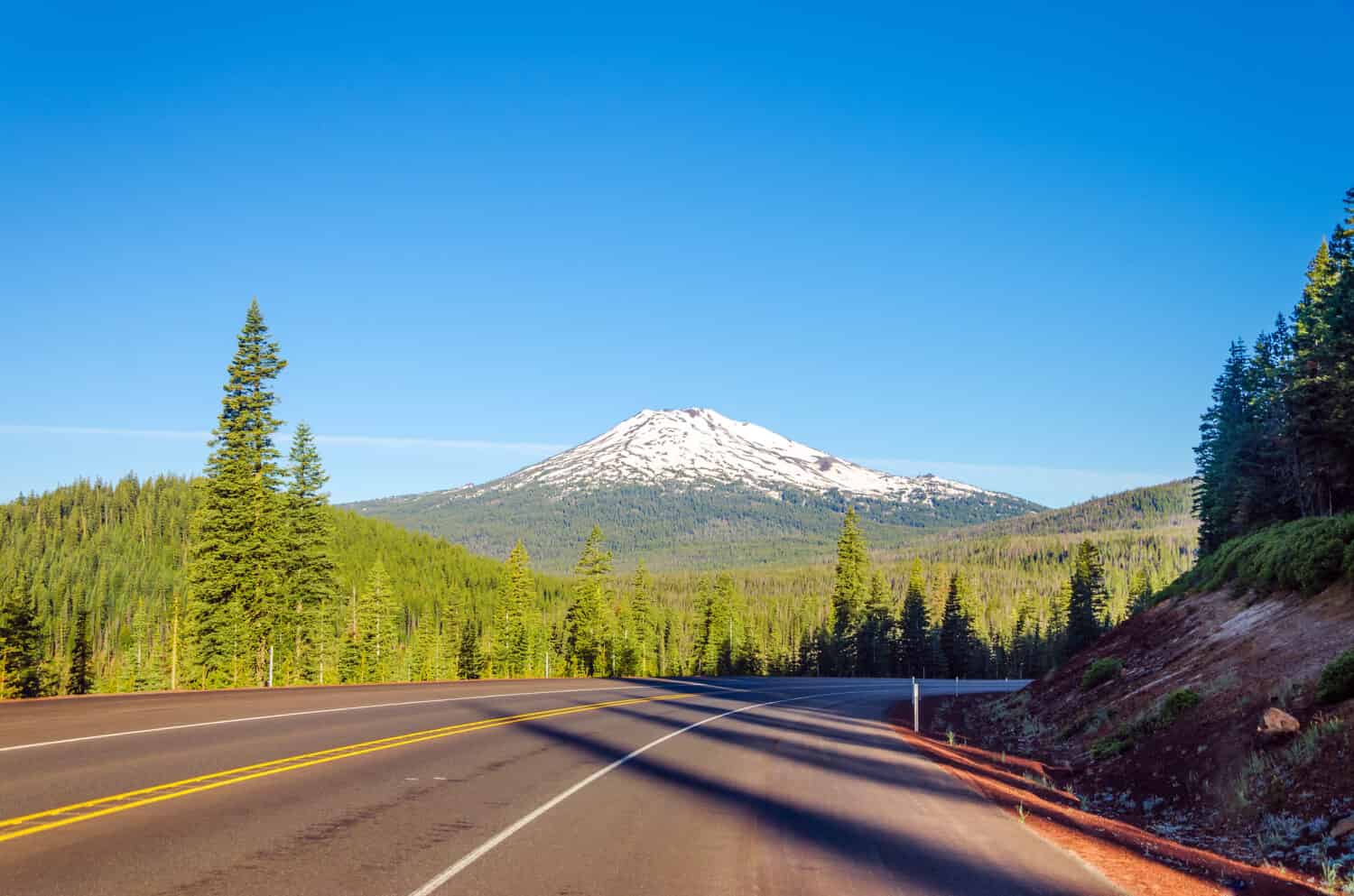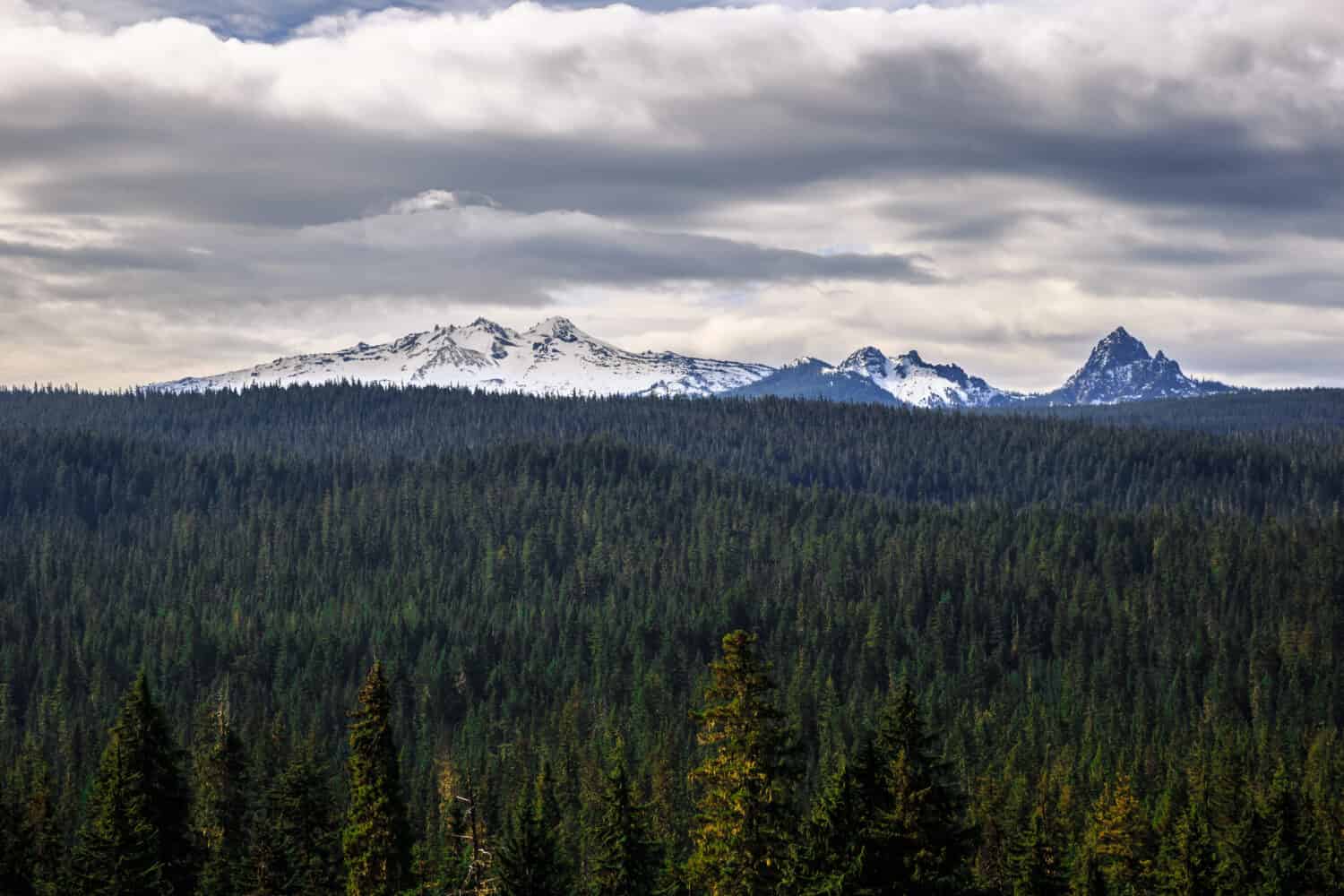Oregon is home to dozens of mountain ranges, of which volcanic eruptions formed many peaks. An impressive 61 volcanoes can be found in the state, but some of the tallest volcanoes in Oregon are true wonders to behold, full of unique wildlife and flora.

We’ve assembled a list of the top 9 volcanoes in Oregon and covered everything you could want to know about their last eruption, current ecology, and where you can visit them.
1. Mt. Hood

Mount Hood’s glacial melt serves as an important water resource for the nearby city of Portland, Oregon.
©ESB Professional/Shutterstock.com
Mount Hood holds the title for both the highest peak and tallest volcano in Oregon, stretching up 12,240 feet tall. Ecologists classify Mount Hood as a stratovolcano, formed over thousands of years with different types of materials creating the peak we know today. The volcano is considered dormant, with its most recent eruption dating back to the 17th century. While an eruption in the near future is unlikely, Mount Hood is far from extinct.
The towering Mount Hood serves as a permanent backdrop to Portland and plays a vital role in the region’s water resources and ecological diversity. The peak overlooks Mount Hood National Forest, home to numerous plants and wildlife, including Douglas-fir trees and Ponderosa pine trees. Animals such as wolves, elk, cougars, and spotted owls make their home near Mount Hood, while salmon rely on snow melts as a crucial watershed for spawning.
2. Jefferson

Mount Jefferson was formed by several small volcanic events and two huge eruptions 290,000 years ago.
©Structured Vision/Shutterstock.com
Mount Jefferson volcano is the second-highest volcanic peak in Oregon, clocking in at 10,495 feet in size. Jefferson is thought by researchers to be the culmination of several eruptions across the peak’s southern Cascade crest. The last eruption occurred over 15,000 years ago, but the stratovolcano was most significantly formed in two major eruptions dating back about 290,000 and 70,000 years. Flow deposits have been found as far as 9.3 miles from the volcano, indicating how significant these eruptions might’ve been.
Lewis and Clark named the peak to honor President Thomas Jefferson, who funded their exploration. Today, the mountain is heavily eroded and covered with glaciers, but the surrounding region still holds diverse wildlife and plants. The wilderness area in the Cascade Range, part of Willamette National Forest, is home to coyotes, deer, black bears, and bald eagles. The surrounding lakes, including Marion Lake, are home to fish like rainbow trout and amphibian species.
3. South Sister

The Three Sisters, comprised of the North Sister, Middle Sister, and South Sister, are nicknamed “Faith,” “Hope,” and “Charity,” respectively.
©Structured Vision/Shutterstock.com
The South Sister volcano is one of three peaks in central Oregon’s Cascades, including the Middle and North Sister mountains. The three peaks each stretch over 10,000 feet tall, but the South Sister, also known as “Charity,” stands tallest at 10,358 feet. The group forms a stunning landmark in the Cascades mountain range, with many climbers flocking to scale South Sister’s peak.
The Three Sisters are the center of a region of closely grouped volcanoes in the Cascades, but each was formed in different processes. The main volcanic component of South Sister formed about 50,000 years ago, making it the youngest of the three, but the peak hasn’t been active in about 2,000 years. Unlike its sister peaks, South Sister has shown persistent underground activity. As such, the United State Geological Survey (USGS) is monitoring the peak for changes in magma inflation.
The Three Sisters’ ecological diversity boasts many species of plants and animals. Douglas fir trees and other timber species dot the sides of the mountains, while fauna such as chipmunks, deer and elk, black bears, weasels, and hawks make their home along the range.
4. McLoughlin

Various pine and fir tree species cover Mount McLoughlin’s slopes, providing a beautiful home for diverse fauna.
©Nature’s Charm/Shutterstock.com
Mount McLoughlin is the fourth tallest volcano in Oregon, measuring 9,492 feet. Standing between Mount Shasta and Crater Lake, the peak is tall but relatively small overall, measuring only three cubic miles. Mount McLoughlin is considered a dormant composite volcano, with its last eruption occurring around 10,000 years ago.
Throughout the year, the sides of McLoughlin bustle with Shasta red fir, mountain hemlock, and whitebark pine, which host an exciting range of fauna. Visitors to the mountain may spy deer, elk, and even the rare grizzly bear in its forests, and runoff from McLoughlin’s peak serves as the watershed for the southern town of Medford.
5. Thielsen

Mount Thielsen’s distinct hook is one of the most recognizable peaks in Oregon.
©Nature’s Charm/Shutterstock.com
Standing tall in the Umpqua National Forest just outside Roseburg, Oregon, Mount Thielsen stretches 9,182 feet into the sky. It’s hard to miss its distinct horn-shaped peak, formed by a shield volcano that erupted about 250,000 years ago. Created by millennia of glacial erosion, its horn is famous for attracting bolts of lightning during storms. This has led many to refer to Thielsen by its nickname, “The Lightning Rod of the Cascades.”
Mount Thielsen offers plenty of hiking and backcountry skiing opportunities for the adventurous visitor and rewards such folks with beautiful alpine lakes, gorgeous flora like mountain hemlock and Douglas firs, and interesting fauna. Miller Lake is home to plentiful brown trout, while birds such as mallards, Canada geese, and bald eagles soar over the range. Adventurous hikers may spy elk, bobcats, pronghorns, and black bears among the trees.
6. Bachelor

Mount Bachelor is a popular skiing destination just outside of Bend, Oregon.
©Structured Vision/Shutterstock.com
Mount Bachelor, formerly called Bachelor Butte, lies in central Oregon along the same Cascade range as the South Sister. The peak stretches 9,065 feet high and is a composite volcano formed by many small shields, cinder cones, and lava flows. Its most recent eruption occurred around 6,000 years ago, and the peak is considered dormant.
Bachelor lies in Deschutes National Forest, about 21 miles west of Bend, Oregon, and attracts visitors far and wide for its winter sports, bicycling, and mountaineering opportunities. Its forests include plenty of mountain hemlock and pines and feature plenty of volcanic talus flora as you approach the peak. The pronghorn makes Mout Bachelor its home, as do the pygmy rabbit, the mountain quail, and predators like Cooper’s hawk and the burrowing owl.
7. Diamond Peak

Dormant and possibly extinct, Diamond Peak’s last eruption occurred at an unknown time within the last 100,000 years.
©Beach Creatives/Shutterstock.com
Diamond Peak is a shield volcano that stretches just over 8,743 feet high in the Willamette Pass. Researchers estimate its last eruption occurred sometime within the last 100,000 years but not later than the last glacier period about 11,000 years ago. Diamond Peak offers visitors plenty of natural beauty, with numerous trails winding their way to the summit.
Visitors can also explore the vibrant wildlife around Diamond Peak in the greater Willamette National Forest. Douglas fir, western white pine, and noble fir proliferate in these woods, which visitors can view while biking, hiking, camping, or horseback riding. Animals like Roosevelt elk, snowshoe hares, black bears, and cougars call Diamond Peak their home, as do several trout species found in the wilderness lakes and streams.
8. Crater Lake Volcano

Crater Lake is the second-deepest lake in the United States.
©Nature’s Charm/Shutterstock.com
The lovely Crater Lake lies in the southern Cascade Range and, contrary to its name, is a caldera that stands 8,159 feet above sea level. It was formed by the collapse of a massive volcano called Mount Mazama nearly 6850 years ago, one of the largest known eruptions on Earth in the past 10,000 years. The resulting collection of ice and rainwater formed it into one of the most beautiful water landmarks in the country, stretching almost 2,000 feet deep. The latest eruption of the caldera was about 4200 years prior, which formed the small Wizzard Island at the lake’s center.
Crater Lake’s beauty and natural treasures draw adventurers nationwide to its sparkling waters. Squirrels, Canada jays, and a lovely array of butterflies and other colorful insects populate Crater Lake National Park, among thousands of other species. Occasionally, you may spot Black bears and other hibernating species, while native trout and some invasive fish species make Crater Lake itself their home.
9. Newberry

Newberry Volcano is considered to be a very high threat even though it hasn’t erupted in 1,300 years.
Image: Jason Cornell, Shutterstock
©Jason Cornell/Shutterstock.com
Newberry is a shield volcano just outside of Bend, stretching at its highest peak (Paulina Peak) up to 7,984 feet above sea level. Even though it last erupted 1,300 years ago, scientists still consider the volcano active with a “very high” threat level. Newberry is also one of the largest volcanos in Oregon in terms of size, with a 75-mile stretch of:
- Active lava flows
- A four-by-five mile caldera
- 400 vents
All this adds up to about the size of Rhode Island.
Despite its active status, many animal species make their home in the Newbery National Volcanic Monument. Birds such as osprey and bald eagles commonly frequent Paulina Lake, home to kokanee salmon and other trout species. Black bears, deer, and raccoons are also among the wildlife variety found in the region.
Summary of the 9 Tallest Volcanoes in Oregon
| Volcano | Height | |
|---|---|---|
| 1 | Hood | 12,240 feet |
| 2 | Jefferson | 10,495 feet |
| 3 | South Sister | 10,358 feet |
| 4 | McLoughlin | 9,492 feet |
| 5 | Thielsen | 9,182 feet |
| 6 | Bachelor | 9,065 feet |
| 7 | Diamond Peak | 8,743 feet |
| 8 | Crater Lake | 8,159 feet |
| 9 | Newberry | 7,984 feet |
Thank you for reading! Have some feedback for us? Contact the AZ Animals editorial team.







